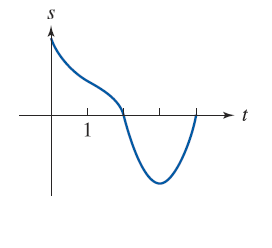(b) A 1 When is the velocity of the particle positive? When is it negative? When is the particle speeding up? When is it slowing down?
(b) A 1 When is the velocity of the particle positive? When is it negative? When is the particle speeding up? When is it slowing down?
Advanced Engineering Mathematics
10th Edition
ISBN:9780470458365
Author:Erwin Kreyszig
Publisher:Erwin Kreyszig
Chapter2: Second-order Linear Odes
Section: Chapter Questions
Problem 1RQ
Related questions
Question

Transcribed Image Text:**Graph Explanation:**
The graph displays the position \( s \) of a particle as a function of time \( t \). The horizontal axis represents time \( t \), while the vertical axis represents the position \( s \).
**Key Features of the Graph:**
- The curve starts at a positive position and initially decreases, reaching a value of zero around \( t = 1 \).
- After \( t = 1 \), the position becomes negative, reaching a minimum before increasing again.
- The curve shows a periodic undulating motion, indicative of a wave or oscillatory pattern.
**Questions and Answers:**
1. **When is the velocity of the particle positive?**
- The velocity is positive when the slope of the graph (rate of change of \( s \)) is increasing, which occurs when the graph is moving upwards.
2. **When is it negative?**
- The velocity is negative when the slope of the graph is decreasing, which occurs when the graph is moving downwards.
3. **When is the particle speeding up?**
- The particle speeds up when the graph is moving away from the time axis (whether upward or downward), indicating an increase in the magnitude of velocity.
4. **When is it slowing down?**
- The particle slows down when the graph approaches the time axis, indicating a decrease in the magnitude of velocity.
Expert Solution
Step 1: Introduction of the given problem

Step by step
Solved in 4 steps with 16 images

Recommended textbooks for you

Advanced Engineering Mathematics
Advanced Math
ISBN:
9780470458365
Author:
Erwin Kreyszig
Publisher:
Wiley, John & Sons, Incorporated

Numerical Methods for Engineers
Advanced Math
ISBN:
9780073397924
Author:
Steven C. Chapra Dr., Raymond P. Canale
Publisher:
McGraw-Hill Education

Introductory Mathematics for Engineering Applicat…
Advanced Math
ISBN:
9781118141809
Author:
Nathan Klingbeil
Publisher:
WILEY

Advanced Engineering Mathematics
Advanced Math
ISBN:
9780470458365
Author:
Erwin Kreyszig
Publisher:
Wiley, John & Sons, Incorporated

Numerical Methods for Engineers
Advanced Math
ISBN:
9780073397924
Author:
Steven C. Chapra Dr., Raymond P. Canale
Publisher:
McGraw-Hill Education

Introductory Mathematics for Engineering Applicat…
Advanced Math
ISBN:
9781118141809
Author:
Nathan Klingbeil
Publisher:
WILEY

Mathematics For Machine Technology
Advanced Math
ISBN:
9781337798310
Author:
Peterson, John.
Publisher:
Cengage Learning,

